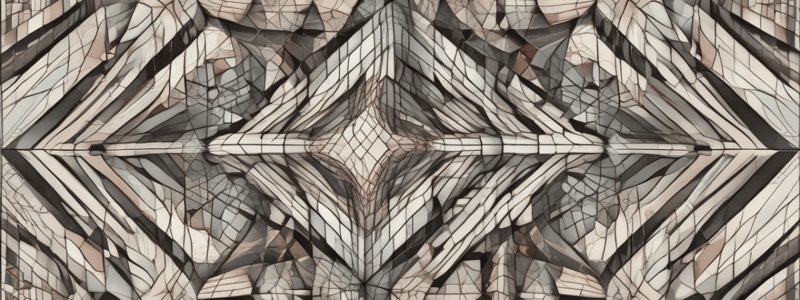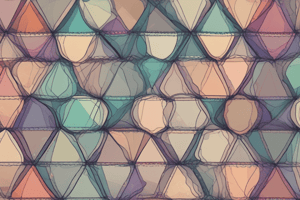Podcast
Questions and Answers
What can be identified by analyzing the arrangements of blue, yellow, and red tiles?
What can be identified by analyzing the arrangements of blue, yellow, and red tiles?
- The number of red tiles, which is a variable
- The number of blue tiles in each arrangement
- The pattern of the arrangement's shape
- The number of yellow tiles, which is a constant (correct)
In the sequences of black, grey, and white squares, what can be described?
In the sequences of black, grey, and white squares, what can be described?
- The number of arrangements possible
- The number of black tiles in each arrangement
- The number of grey tiles in each arrangement
- The pattern of grey and white squares (correct)
What is the purpose of identifying constants and variables in a pattern?
What is the purpose of identifying constants and variables in a pattern?
- To create a new pattern
- To identify the next term in the sequence
- To calculate the number of tiles in the arrangement
- To understand the structure of the pattern (correct)
What can be done with the pattern of dots in a sequence?
What can be done with the pattern of dots in a sequence?
What is the purpose of creating sequences with different operations?
What is the purpose of creating sequences with different operations?
How can the next terms in a sequence be written?
How can the next terms in a sequence be written?
What is the purpose of formulating relationships between terms in sequences?
What is the purpose of formulating relationships between terms in sequences?
What can be compared when creating sequences with different starting points and operations?
What can be compared when creating sequences with different starting points and operations?
What is the purpose of extending sequences and describing how they are formed?
What is the purpose of extending sequences and describing how they are formed?
What can be done with a sequence once its pattern is identified?
What can be done with a sequence once its pattern is identified?
What is the primary purpose of analyzing arrangements of blue, yellow, and red tiles?
What is the primary purpose of analyzing arrangements of blue, yellow, and red tiles?
In a sequence of black, grey, and white squares, what can be predicted about the future arrangements?
In a sequence of black, grey, and white squares, what can be predicted about the future arrangements?
What is the key difference between a sequence created by adding a specific number and a sequence created by multiplying a specific number?
What is the key difference between a sequence created by adding a specific number and a sequence created by multiplying a specific number?
When creating a sequence with different operations, what is the primary goal?
When creating a sequence with different operations, what is the primary goal?
What is the primary purpose of formulating relationships between terms in sequences?
What is the primary purpose of formulating relationships between terms in sequences?
In a sequence of black and grey squares, what can be identified by analyzing the pattern of grey squares?
In a sequence of black and grey squares, what can be identified by analyzing the pattern of grey squares?
What is the primary benefit of extending sequences and describing how they are formed?
What is the primary benefit of extending sequences and describing how they are formed?
What is the primary purpose of identifying constants and variables in a pattern?
What is the primary purpose of identifying constants and variables in a pattern?
What is the primary benefit of creating sequences with different operations?
What is the primary benefit of creating sequences with different operations?
What is the primary purpose of comparing sequences with different starting points and operations?
What is the primary purpose of comparing sequences with different starting points and operations?




